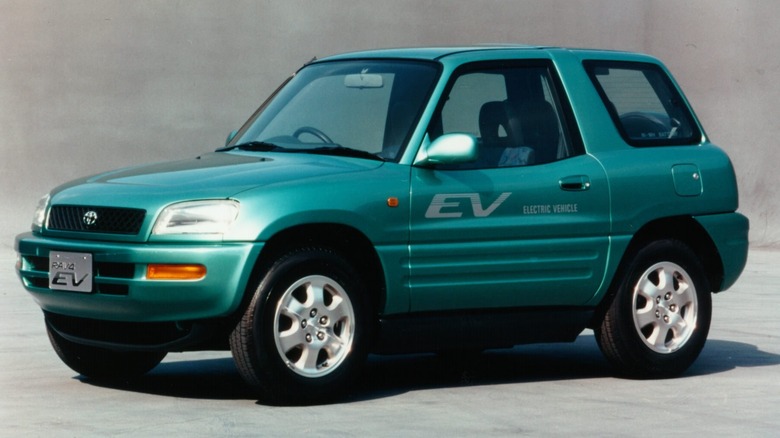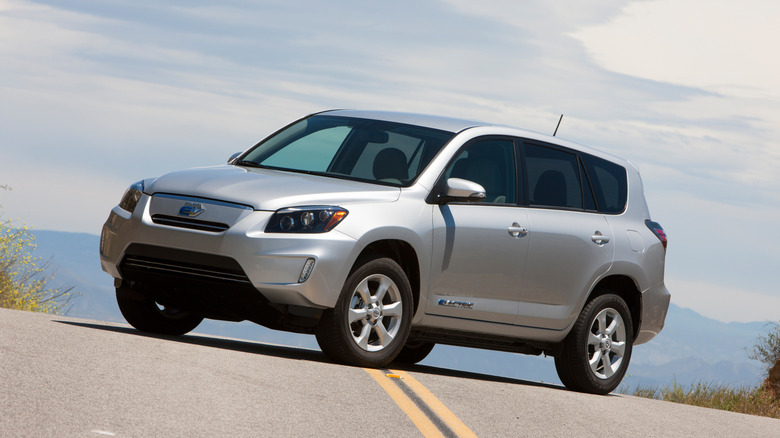
Japanese auto giant Toyota has been experimenting with electric vehicles for a long time before launching its existing crop of EVs, such as the newly-renamed bZ crossover and the stylish CH-R EV. Toyota introduced the first-generation RAV4 EV in 1997, but the automaker began intensive research and development into electric vehicles all the way back in 1969. It wasn't until 1983 that Toyota developed its first EV prototype, the EV-10, based on an E80 Toyota Corolla sedan.
After conceptualizing more
prototypes, the automaker reached a milestone in 1993 when it began selling production variants of the Town Ace EV to local Japanese government bodies. It also leased the Crown Majesta EV to the Tokyo Metropolitan Government that same year.
Toyota unveiled the first RAV4 EV prototype in 1995 for commercial testing in Japan and the United States. The prototype initially came with a sealed lead-acid battery, which could achieve a range of 75 miles (120 km) and a top speed of 77 mph (125 km/h). Toyota and Panasonic co-developed a more advanced nickel-metal-hydride (NiMH) battery for the commercial variant of the RAV4 EV, resulting in a 10% lighter battery pack that offered 1.5 times the energy storage capacity and three times the expected life cycle.
Read more: 10 Toyota Models With Terrible Resale Value
The First-Gen Toyota RAV4 EV Was Not Sold Publicly Until 2002

It's not that the RAV4 EV was a dud. When it launched in 1997, it was one of the world's most advanced electric cars. The new NiMH battery unlocked 67 horsepower from the single electric motor, 121 lb-ft of torque, and a top speed of 77 mph (125 km/h). More importantly, it could deliver a range of 124 miles (200 km) per full charge. However, the first-gen RAV4 was only available for a three-year fleet lease, and it was never sold or leased to private buyers.
Toyota changed its mind in 2002 when it began offering the RAV4 EV for public sale. It did so to comply with the California Air Resources Board (CARB) Zero Emission Vehicle Mandate (ZEV), which took effect in 2003, requiring 10% of all new vehicles sold in California to meet low-emission standards. Aside from having an electric motor and batteries instead of a gas engine and fuel tank, the RAV4 EV had room for five, adequate cargo space, four-wheel anti-lock brakes, alloy wheels, power amenities, and a premium stereo with a CD player.
In other words, the Toyota RAV4 EV is still a practical and daily drivable car, like its internal combustion twin. It even features modern EV quirks, such as a heat pump-type heater/air conditioner and regenerative braking. Then again, its $42,000 MSRP was quite prohibitive for its time, and the $9,000 CARB incentive and $3,000 IRS credit were not enough to sway buyers when an ordinary, gas-powered RAV4 was retailing at under $20,000.
The Second-Generation RAV4 EV Launched In 2012

The second-generation Toyota RAV4 EV had a relatively short production run. The RAV4 EV went on sale from 2012 to 2014 in California and the Bay Area, and Toyota sold or leased approximately 2,600 RAV4 EVs during this period. The MSRP was slightly higher, $49,800 before credits and subsidies. What many people don't know is that the second-gen RAV4 EV utilized similar batteries, powertrain components, and electronics that Tesla used for its first production EV, the Model S sedan.
It came with a 154-horsepower Tesla AC induction motor, making it more potent than the previous RAV4 EV. It also came with a higher-capacity 41.8 kWh lithium-ion battery, currently the best battery type for modern EVs, co-developed by Tesla and Panasonic. All this made the RAV4 EV quicker and more exciting to drive, but the expected driving range fell short of expectations, estimated to be between 93 and 112 miles. The standard 10 kW onboard charger was also courtesy of Tesla, and it came with a J1772 charging port.
The Toyota RAV4 EV, particularly the second-gen model, was essentially a Tesla-powered SUV wearing a Toyota badge. It came before the Tesla Model X reigned in the electric SUV segment, but the credit goes to Tesla for the RAV4 EV's short-lived success. It did fail to capture the buyer's imagination of what an EV should be, but it kicked open the door to the EV revolution that still captivates to this day.
Want the latest in tech and auto trends? Subscribe to our free newsletter for the latest headlines, expert guides, and how-to tips, one email at a time.
Read the original article on SlashGear.













